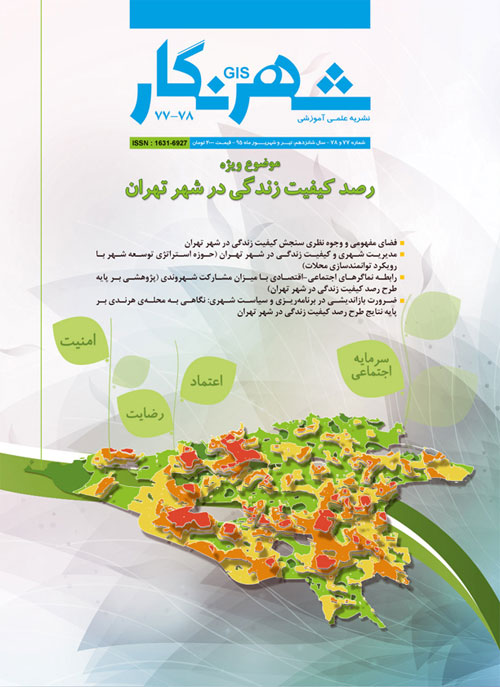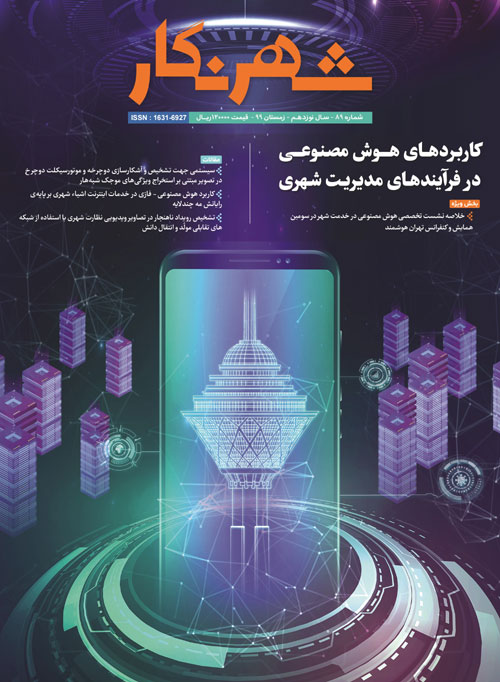فهرست مطالب

دو ماهنامه شهرنگار
پیاپی 77-78 (تیر و شهریور 1395)
- تاریخ انتشار: 1395/06/22
- تعداد عناوین: 13
- یادداشت
-
سخن نخست / سنجش کیفیت زندگی گامی در راستای توسعه پایدار شهریصفحه 3
- بخش ویژه: رصد کیفیت زندگی
-
صفحه 6
-
مدیریت شهری و کیفیت زندگی در شهر تهران / حوزه استراتژی توسعه شهر با رویکرد توانمند سازی محلاتصفحه 32
-
رابطه نماگرهای اجتماعی-اقتصادی با میزان مشارکت شهروندی / پژوهشی بر پایه طرح رصد کیفیت زندگی در شهر تهرانصفحه 46
-
ضرورت بازاندیشی در برنامه ریزی و سیاست شهری: نگاهی به محله ی هرندی / بر پایه نتایج طرح رصد کیفیت زندگی در شهر تهرانصفحه 58
- نگاهی دیگر
-
تعریف کیفیت زندگی شهری:کدام عوامل در نظر گرفته شود؟ / اواپی ساته ا، آلکس دفنر، یانیس سایکاریس ارائه شده در پنجاه و یکمین کنگره انجمن علوم منطقه ای اروپا، اسپانیا، بارسلون ژانویه 201صفحه 73
- گفتگو
- رویدادهای علمی و اجرایی
-
صفحه 96
-
چکیده انگلیسیصفحه 101
-
Page 15QOL (Quality of Life) is a common concepts in the field of human sciences, from sociology and health to urban management and psychology. This sense when seen from the perspective of urban planning, would be tied up with concepts such as city, citizenship and urban planning. Despite all extensive efforts and diverse has been done in the world and in the last two decades, in Iran to evaluate this concept, QOL still constitutes as an important variable in studies of urban planning that has not been precisely defined and its assessing has always been a practical challenge in the field of urban management. In last few years, as trends growing and polling organizing in the city and the citizens, special attention is paid to the quality of urban life. This article try to get a picture of these efforts in the specific area in QOL, that talk about urban quality of life and more precisely the quality of life in urban neighborhoods. The basic aim of this paper is to describe the process of conceptualizing and introduce a tool to assess the quality variable of urban life. In 1395 this tool was used to assess quality of life in each neighborhoods of Tehran and its construct validity was studied according to data we found and statistical analysis that was done. This article explain theoretical aspects of the process and give you the results. To conceptualize the notion of quality of urban life, before anything it seems to be necessary that this concept clarified according to more general concept of quality of life. So we referred to the literature of this concept and try to recognize its dimensions and components. We use theoretical and conceptual framework, and with deductive reasoning and generalization, theoretical definition and concept has been Reviewed. To select conceptual framework, after reviewing the macro theory of Bourdieu's theory of social capital and Parsons social systems as a macro theory and concepts related to those concepts such as city, neighborhood, citizenship, studied quality of life in middle the theoretical framework was built and was criticized by some experts. Finally concepts of social capital and social order, such as distributive justice, neighborhood identity, security, social participation, social trust and otherwise as components of quality of life in Tehran were selected that this article would explain each one of them and it studies their relations.Keywords: Quality of urban life, quality of life, community, social capital city, neighborhood social system, social trust in their local neighborhoods, community involvement, exploitation of municipal services, satisfaction of urban neighborhoods, Tehran
-
Urban Management and Quality of Life in Tehran: / City Development Strategy with focus on Enhancement ApproachPage 32Nowadays quality of life discusses as a key element of policy making and Analyzing the public policy, and the relationship between objective/subjective factors, levels of performance, social needs and the rate of their achievements for people in dimensions of health, education, economic welfare, happiness, capability and control to situations and life chances are studied by researchers in various methods. The aim of this study is to investigate the effects of urban management policy-making and implementations on quality of life index in Tehran. Within the review of theoretical literature about two concepts of urban quality of life and good city governance, this study analyses the evolution of quality of life in Tehran by using secondary analysis method. Methodology of this study based on factor analysis, numeric taxonomy and cluster analysis. With adoption to tentative and theoretical background in world and Iran, 64 indexes were selected and districts of Tehran in quality of life grouped in three sectional periods by using advanced statistical methods such as factor and cluster analysis and numeric taxonomy. Results show the improvement in degree of quality of life in Tehran in recent years. In addition results indicate that the set of implementations of urban management in Tehran was lead to decrease in cluster gap and increase of convergence in quality of life between 22 districts of Tehran. Focusing on the lack of distinct strategy and approach in Tehran urban management for improving quality of life, this study suggest city development strategy with quarter empowerment approach for permanent improvement in quality of life.Keywords: Urban Quality of Life, City Development Strategy, Empowerment, Good Governance
-
The Importace of Rethinking in Urban planning Methods and Urban Policy, Case Study: Harandi Neighbourhood / Based on the results of project measuring quality of life in TehranPage 58In recent decades, through global transformations, the quality of urban issues in Tehran has undergone fundamental changes. Nowadays we are confronting entirely new issues in cities. In this confrontation, urban planning has serious deficiencies. Instead of applying a radical view, it is emphasizing on immediate measurements and in this way, theorizing is being meaningless. Such a trend is very dangerous because renders urban planning and policy irrelevant. The main problem is lied in the methodology of the dominant approaches in planning. This approaches, use old and new concepts and theories without any critical consideration. While we are essentially facing a new emergent phenomenon: urbanization and production of space on a planetary scale. This new phenomenon is unprecedented. Therefore, the new issues derived from the new phenomenon are unique. Consequently, we need new methods and approaches to understand the new issues. Any analyses of urban question in Iran must be considered in connection with this larger context. Spatial inequality must be conceptualized on the extended framework. Thus, we should focus on this emergent form the process of urbanization and production of space and its internal reproduction mechanism. We should introduce relations and forces into analysis which are operating on various levels, and place cases like Harandi Neighborhood in this extended picture. Otherwise, the analysis is merely restricted to the appearances and we cannot understand more fundamental processes and structures which create these appearances. In this paper, by focusing on Harandi neighborhood, it is demonstrated that the most important barrier exists before resolving urban issues, is the dominant approaches of urban planning system. The most important defect of the dominant approaches is lack of holistic view and thus their fragmentary dealing with the problem. It is argued that issues such as Harandi neighborhood, come from interconnection and interaction of forces and logics existing on various global, national and local scales which are simultaneously economic, political, conceptual and physical. To confront urban issues, it is needed to employ integrated, holistic and complicated approach which is devoid of current reductionisms. Such an alternative approach can be reconstructed on the basis of the political economy of space, and particularly on the Lefebvre's theory of the production of space.Keywords: urban planning, urbanization, methodology, neoliberalism, political economy of space, production of space, Harandi, Tehran


